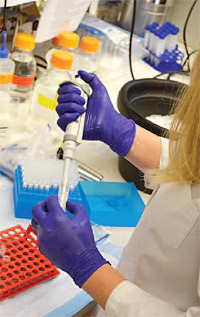Advanced Platform Technology Center
Developing Polymer Muscle Substitutes
 Over 3 million patients per year are diagnosed with neurological disorders that result in significant muscle weakness. No currently available orthotic device can improve the muscle strength of individuals with such progressive neuromuscular diseases. A number of wearable robotic exoskeletons actuated by electric motors are on the market, but their size, weight, cost, and power requirements are significant impediments to daily use and might actually accelerate the deterioration of the proximal musculature.
Over 3 million patients per year are diagnosed with neurological disorders that result in significant muscle weakness. No currently available orthotic device can improve the muscle strength of individuals with such progressive neuromuscular diseases. A number of wearable robotic exoskeletons actuated by electric motors are on the market, but their size, weight, cost, and power requirements are significant impediments to daily use and might actually accelerate the deterioration of the proximal musculature.
Both muscle atrophy from disuse with muscle destruction from overuse will both cause muscle loss and further weakness. Our group has started to develop lightweight, flexible exoskeletons, using "smart" biomimetic polymer actuators that might eventually help a user maintain the steady- state between disuse atrophy and overuse destruction, thus potentially altering the course of the disease and increasing the time over which natural muscle mass can be retained. APT Center Investigators envision a new class of external orthoses that can be as light and comfortable as a piece of clothing, while still able to generate the assistive power necessary to amplify user strength and coordinate complex muscle movements.
The most crucial step in creating these novel exoskeletons is the development of lightweight, biomimetic polymer actuators that can function as "artificial muscles" within the orthoses. This project involves designing and fabricating these artificial muscles. Our preliminary research indicates that dielectric elastomers may be the best class of materials to duplicate the properties of natural muscle, and thermoplastic polyurethanes are four times more electromechanically powerful than any other commercially available dielectric elastomer. After optimizing these electrically active polymers, the goal is to incorporate the artificial muscles into lightweight and dynamic orthotic devices that can generate supplemental power to assist in the completion of voluntary movements, or provide controlled resistance for rehabilitation and reconditioning exercise, without causing muscle damage.
Principal Investigator: Rahila Ansari, M.D., M.S.
Clinical Collaborator: Robert Ruff, M.D.
Funding Source: Lubrizol




















